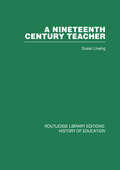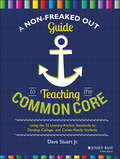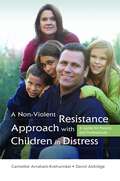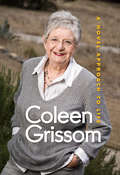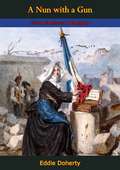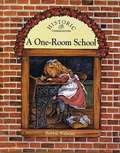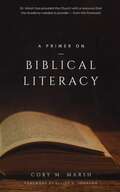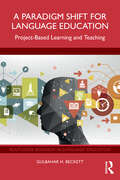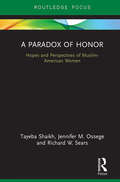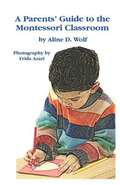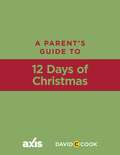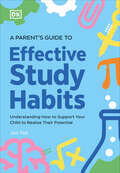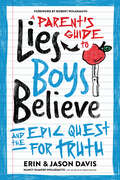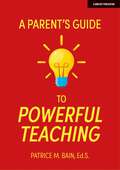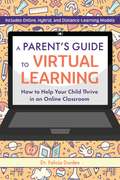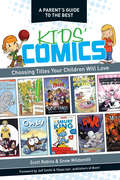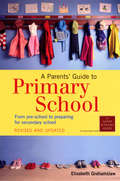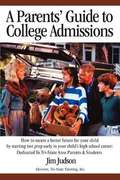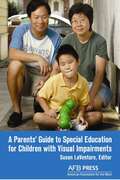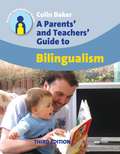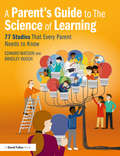- Table View
- List View
A Nineteenth Century Teacher: John Henry Bridges
by Susan LiveingOriginally published in 1926 and whilst not a biography in the strictest sense, this volume presents John Bridges’ life and character against the social and political background of the nineteenth century as well as examining his legacy for current generations.
A Non-Freaked Out Guide to Teaching the Common Core
by Dave Stuart Jr.Implement the Common Core for ELA without all the stress A Non-Freaked Out Guide to Teaching the Common Core uses the often-neglected anchor standards to get to the heart of the Common Core State Standards (CCSS)--teaching students the skills they need to be college and career ready. Each anchor standard is broken down into its key points, and a discussion of each anchor standard's central purpose helps outline the context for each required skill. This easy-to-read guide gives educators the kind of clear explanations, examples, and strategies they need to feel comfortable teaching the CCSS, and shows how CCSS skills can be integrated into virtually any existing lesson plan. Getting a firm grasp of the anchor standards is the quickest way to start teaching the key concepts of the CCSS, and this user-friendly guide is designed to pave the way for both the first-time teacher and the experienced pro.
A Non-Violent Resistance Approach with Children in Distress
by David Aldridge Carmelite Avraham-KrehwinkelParents, teachers and other professionals often struggle to know how to deal with disruptive, abusive or aggressive behaviour. This book addresses the urgent need for a realistic, practical and effective approach to dealing with severe disruptive behaviour in children and adolescents. Adapting the principles of non-violent resistance originally advocated by Mahatma Gandhi, the book provides de-escalation techniques which empower the adult and unburden the distressed child. The authors outline the theoretical basis upon which the approach was developed, and explain how and why it can be so effective. Case studies demonstrate how the approach can be used to reach more successful places with unhappy and disruptive children of different ages. A separate section for parents provides useful advice on how to take the theoretical material and use it to deal with problematic behaviour in everyday life. As effective as it is original, this approach will empower desperate parents and despairing caregivers by equipping them with hands-on tools to contain, counter and positively direct the aggression and opposition which they face from children in distress.
A Novel Approach to Life
by Coleen GrissomAs an administrator and teacher at San Antonio's Trinity University for five decades, Coleen Grissom saw the rise of feminism, the sexual revolution, and the tragic deaths of students, friends, and family. This varied collection assembles the best of her speeches probing these and other timely issues, from drug use and freedom of speech to AIDS and racism. More than the sum of its parts, this book, filigreed with pithy literary insights, offers an astute chronicle of its times that gives readers good reasons to embrace literature and life.
A Novel Approach to Life
by Coleen GrissomAs an administrator and teacher at San Antonio's Trinity University for five decades, Coleen Grissom saw the rise of feminism, the sexual revolution, and the tragic deaths of students, friends, and family. This varied collection assembles the best of her speeches probing these and other timely issues, from drug use and freedom of speech to AIDS and racism. More than the sum of its parts, this book, filigreed with pithy literary insights, offers an astute chronicle of its times that gives readers good reasons to embrace literature and life.
A Nun with a Gun, Sister Stanislaus: A Biography
by Eddie DohertyTHIS is the story of a rare human being, a dynamo of a woman who devoted her life, joyfully, humorously, expertly, uniquely, to others.Orphaned at 3, brought up by the Sisters of Charity in Nevada, a nun herself at 20, Sister Stanislaus, after several months of nurses’ training in Baltimore, was sent to work in New Orleans. She never really left. Her first, last, and only assignment was Charity Hospital, New Orleans. In time, the two became virtually synonymous.She spent over fifty years there. When she arrived, Charity Hospital comprised one antiquated building; modern medicine was in its swaddling clothes; nursing was an even more hit-or-miss affair. When she left, Charity Hospital was one of the finest in the land and nursing had become a highly professional career.Sister Stanislaus played a large part in the development of both. She brought to nursing a great and joyful zeal, an originality, and a love which affected everyone she came in contact with. Constantly perfecting herself as a nurse, she became one of the best known nursing-sisters in the country.But she did not stop there. Changing, innovating, wheedling money from a string of politicos—from Huey Long and his predecessors by Earl Long—she built Charity Hospital into the great modern institution it is.Yet her fame and her influence were not a result of her public achievement; they were based upon something more immediate, more spiritual. They grew from her all-embracing charity, her lifetime of devotion to the sick and the troubled. She was beloved as a person; the rest, an incredible array of activities and duties, accomplishment and concern, simply happened. Or so she pretended.An extraordinary personality merges from this brisk, expertly written biography, a lively and highly original nun, nurse, and human being, full of surprises but indefatigably on the job, bringing relief and consolation to thousands who passed in and out of a great hospital.
A One-Room School
by Bobbie KalmanThis book talks about how schools got started. It may be difficult to believe there was a time when few communities had schools. Children of all ages were taught in the same classroom.
A PRIMER ON BIBLICAL LITERACY
by Cory M. MarshWhat is Biblical Literacy? Suprisingly, not much has been published addressing this topic, Filling the void, this highly accessible introduction to the subject answers why Christians need to be biblically literate, what biblical literacy is, and how it is achieved. Though interpretive challenges face every reader of Scripture, they need not keep believers from gaining awareness of and proficiency in the Bible's clear teaching. Guided by the principle that the Bible can-and should-be understood, A Primer on Biblical Literacy, is a handy tool that will help readers achieve biblical literacy, and grow in their understanding of, and reverence for, God's Word.
A Paradigm Shift for Language Education: Project-Based Learning and Teaching (Routledge Research in Language Education)
by Gulbahar H. BeckettThis book investigates the argument for the significance and necessity of project-based learning and teaching (PBLT), as it becomes increasingly important in language education.Drawing on research and professional literature spanning over 100 years, it explores the research foundations and the historical and theoretical antecedents of PBLT, articulating the application of PBLT as a valuable approach for second language education pedagogy and research. Utilizing qualitative classroom research conducted in Canada, it then moves to address key concerns surrounding the difficulties of effectively implementing PBLT with existing curriculum and keeping track of content acquisition, cognitive and social skills development, and language learning.Authoritatively written, and offering fresh insight into how the field can be advanced by engaging second language (L2) students in deeper learning and higher order thinking with 21st-century PBLT contextually, situationally, and multimodally, it makes a valuable pedagogical and research contribution that benefits practitioners and researchers in the field. As such, it will appeal to researchers, faculty, and L2 professionals with interests in L2 education, multimodal teaching and learning, and applied linguistics.
A Paradox of Honor: Hopes and Perspectives of Muslim-American Women (Researching Social Psychology)
by Richard W. Sears Tayeba Shaikh Jennifer M. OssegeBased on original interviews of 22 Muslim-American women of South Asian descent on the topics of honor and honor killings, this book examines honor and culture, and their intersections with power, tradition, gender, family, and religion. Additionally, it incorporates an autoethnographic approach describing the author’s journey to Pakistan to create a personal narrative throughout. This volume offers a unique perspective that allows for informed exploration and description of Muslim-American women’s attitudes and beliefs surrounding the practice of killing women and girls in order to regain family honor.
A Paraprofessional's Handbook for Working with Students Who Are Visually Impaired
by Cyral Miller Nancy LevackThis book was written to help increase the effectiveness of paraprofessionals and identify ways to help them work with the visually impaired. It stresses team work with other education professionals and gives first hand suggestions to overcome challenges to help the student grow.
A Parent's Guide To Montessori Classroom(revised)
by Aline D. WolfThis booklet describes in detail the Montessori program for children between the ages of three and six. It is designed to help you, the par¬ents, understand the long-range purpose of Montessori education and to give you a description of the equipment that your child will be using for approximately three years. This information may also interest your child's future teachers, who may want to know the details of his or her earlier learning experience.
A Parent's Guide to 12 Days of Christmas (Axis Parent's Guide)
by Axis4 calling birds, 3 french hens, 2--Wait! <P><P That's not what the 12 days are at all. <P><P>Use this Guide to learn about the real 12 days of Christmas, why they matter, and how to begin more meaningful Christmas traditions. <P><P>(Note: This is not a devotional.)
A Parent's Guide to Effective Study Habits
by Jon Tait DKHelp your child create the perfect study conditions at home to give them the support they need when studying.A Parent's Guide to Effective Study Habits is for parents and caregivers who want to know how their children learn and perform. Written for parents and caregivers of children aged 10–18, this guide covers a range of proven strategies to help children focus and engage with different types of schoolwork. It contains practical tips on topics like organization, study strategies, preparing for exams, and achieving peak performance using a structured approach.This parent guide to study habits offers: An easy-to-follow approach to help with studying, with jargon-free language.An opportunity to boost home learning for parents and caregivers who want to support their children at home.Content by expert author Jon Tait, Deputy CEO and Director of School Improvement at a multi-academy trust.The book is written using accessible, jargon-free language that is easy to follow and understand. Strategies are clearly laid out with clear, step-by-step instructions and notes on any equipment you'll need. The science behind the strategies is explained in easy-to-digest, bitesize chunks, and there are useful tips on what to avoid and how to take things further for the best results.More in the seriesA Parent's Guide to Effective Study Habits is part of the DK Super Phonics range, helping parents and caregivers with home learning. The collection includes A Parent's Guide to Phonics, and DK Super Phonics workbooks, stories and card games.
A Parent's Guide to Lies Boys Believe: And the Epic Quest for Truth
by Erin Davis Jason DavisLies are powerful. Your son has a persistent enemy who seeks to deceive and rob him of the confidence and strength he has in Jesus. But you can help him fill his heart with God&’s Truth so that he can stand strong.A Parent&’s Guide to Lies Boys Believe, a companion book to Lies Boys Believe, is your tool to come alongside your son in the fight against lies. This unique and Bible-centered resource teaches your son the Truth he will need to navigate the challenges he is facing. Join the fight against lies using this guide, packed with encouragement and biblical insight. Written by two experienced parents with a house full of boys and a heart to raise up a generation of Truth-seekers, you&’ll be empowered to talk with your son and push back against the Deceiver.Together, these books give you the tools you need to start important conversations. A Parent&’s Guide to Lies Boys Believe will help you:Develop and communicate a right theology of lies and Truth to your sonInitiate meaningful ongoing conversations about the topics like: the gospel, God&’s Word, entertainment choices, self-control, and more.Build a Word-centered home
A Parent's Guide to Powerful Teaching
by Patrice Bain“I’m not sure how to help my child with schoolwork.” “I see my child study for tests and not do well.” “How much help is too much? Or Not enough?” As a parent, do you have questions like these? For students reading this book, have you ever thought: I studied all night and didn’t do well on the test? Do you question why spending more time on schoolwork often does not reflect increased learning or higher grades?We all think we know how to study. Many of us have spent years in educational settings. Because we have learned, do we know how learning occurs? Often the answer is no. Fewer than 10% of students have parents who are certified educators. Where can the other 90% of parents go to find answers? If you are a student, where can you go to find out how to maximize learning while spending less time doing so? The answer is this guide. Patrice Bain has shown thousands of students with a wide range of abilities how to increase school performance. Having worked with cognitive scientists in the classroom for over half of her 25+ year teaching career, Bain knows how students learn and has developed strategies that increase memory, grades and retention of material. This book is not about fads or the latest shiny gadgets. Instead, this guide, based on rigorous research, gives the inside look into how all of us learn best. Filled with stories making learning relevant, and strategies to use at home, this guide will be like having a seat in Mrs. Bain’s engaging classroom.
A Parent's Guide to Powerful Teaching
by Patrice Bain“I’m not sure how to help my child with schoolwork.” “I see my child study for tests and not do well.” “How much help is too much? Or Not enough?” As a parent, do you have questions like these? For students reading this book, have you ever thought: I studied all night and didn’t do well on the test? Do you question why spending more time on schoolwork often does not reflect increased learning or higher grades?We all think we know how to study. Many of us have spent years in educational settings. Because we have learned, do we know how learning occurs? Often the answer is no. Fewer than 10% of students have parents who are certified educators. Where can the other 90% of parents go to find answers? If you are a student, where can you go to find out how to maximize learning while spending less time doing so? The answer is this guide. Patrice Bain has shown thousands of students with a wide range of abilities how to increase school performance. Having worked with cognitive scientists in the classroom for over half of her 25+ year teaching career, Bain knows how students learn and has developed strategies that increase memory, grades and retention of material. This book is not about fads or the latest shiny gadgets. Instead, this guide, based on rigorous research, gives the inside look into how all of us learn best. Filled with stories making learning relevant, and strategies to use at home, this guide will be like having a seat in Mrs. Bain’s engaging classroom.
A Parent's Guide to Virtual Learning: How to Help Your Child Thrive in a Online Classroom
by Felicia DurdenMake kids&’ virtual school experience fun and effective with this all-in-one primer designed to help busy parents make the most out of digital platforms, understand teaching strategies, and fully support your child&’s education.Every parent wants to help their child succeed, but it can be difficult when online platforms and teaching methods seem to be constantly changing. Now, A Parent&’s Guide to Virtual Learning takes the mystery out of digital education and gives you the tools that you can immediately implement at home, no matter your district, school, or distance learning model. Written by a fellow parent and experienced educator, Dr. Felicia Durden breaks down how virtual learning works and simple strategies for reinforcing classroom instruction, all with the busy parent in mind. In this book, parents will learn how to: Create an inspiring at-home workspace Make the most out of virtual platforms Understand core topics like math and reading Set up remote learning pods with other kids Support various online, hybrid, and distance learning models Avoid burnout (for students and parents!) Adapting to a virtual environment will be challenging and the role that parents play is crucial in student success. This book will be a tool that you will go to again and again to stay prepared and energized each day to help your child reach their learning goals.
A Parent's Guide to the Best Kids' Comics: Choosing Titles Your Children Will Love
by Scott Robins Snow Wildsmith"Children are made readers on the laps of their parents."--Author Emilie Buchwald Filled with beautifully illustrated reviews and a wealth of recommendations, A Parent's Guide to the Best Kids' Comics lovingly and thoughtfully reveals a world of graphic novels sure to capture the imagination and curiosity of your child. Children's literature experts and library professionals Scott Robins and Snow Wildsmith select and review 100 age-appropriate books, and recommend another 750 titles for children from pre-kindergarten to eighth grade in this full-color, first-of-its-kind guide. You'll also find an educator's bibliography, website recommendations, and a bounty of resources to make this magical journey informative as well as delightful. Jeff Smith and Vijaya Iyer, producers of the highly acclaimed and award-winning Bone series, provide a Foreword for the book.
A Parents' Guide To Primary School
by Elizabeth GrahamslawEducation is an obsession for parents and children alike and parents will worry about anything to do with their children's schooling, from which school to choose and when their child should start to what they need to learn and how they'll cope in the playground.Schools are crying out for parents to become more involved in their children's education. A Parents' Guide to Primary School contains indispensable advice on:- Pre-school and choosing the right primary school- Getting ready for school and the first day- The curriculum, SATs, homework and the importance of parents' involvement in their children's learning- Discipline and bullying- Governors and the PTA - how to get involved- Parents' evenings and reports- Extracurricular activities- Special needs- Moving on - preparing for secondary school
A Parents' Guide to College Admissions: Dedicated To Tri-State Area Parents & Students
by Jim JudsonThe book is a wake-up call to parents. For most parents, there is a misconception that good report cards alone are enough. Jim Judson gives an eye opener and a candid account of what it will take parents and students to the best colleges and universities.
A Parents' Guide to College Admissions: How To Secure A Better Future For Your Child By Starting Test Prep Early In Your Child's High School Career
by Jim JudsonA guide to getting an early start on preparing for college.
A Parents' Guide to Special Education for Children with Visual Impairments
by Susan LaventureThis handbook for parents, family members and caregivers of children with visual impairments explains special education services that these children are likely to need and to which they are entitled--and how to ensure that they receive them. Edited and written by experienced parents and professionals, this helpful and easy to use resource addresses the effect of visual impairment on a childs ability to learn and the services and educational programming that are essential for them to get the best education possible. Chapters address early intervention, assessment, different types of services, IEPs, accommodations and adaptations, different types of placements, children with other disabilities in addition to visual impairment, and negotiation and advocacy.
A Parents' and Teachers' Guide to Bilingualism
by Colin BakerIn this accessible guide to bilingualism in the family and the classroom, Colin Baker delivers a realistic picture of the joys and difficulties of raising bilingual children. The Q&A format of this book makes it the natural choice for the busy parent or teacher who needs an easy reference guide to the most frequently asked questions. This revised edition includes more information on bilingualism in the digital age, and incorporates the latest research in areas such as neonatal language experience, multilingualism, language mixing and the effect that siblings have on family language choice.
A Parent’s Guide to The Science of Learning: 77 Studies That Every Parent Needs to Know
by Edward Watson Bradley BuschSupporting parents in the quest to help their children learn as effectively and efficiently as possible, A Parent’s Guide to The Science of Learning translates 77 of the most important and influential studies on student learning into easily digestible overviews. This book will develop parents’ understanding of crucial psychological research so that they can help their children improve how they think, feel and behave in school (and, indeed, in life). Each overview summarises the key findings from the research and offers tips, hints and strategies for how you can use them in your home. Covering important areas such as memory, motivation, thinking biases and parental attitudes, this book makes complicated research simple, accessible and practical. From large- to small-scale studies, from the quirky to the iconic, this book breaks down key research to provide parents with the need-to-know facts. Essentially, it is a one-stop shop that offers guidance on how to parent even better. A Parent’s Guide to The Science of Learning answers the sort of questions that every parent wants to know but doesn’t know where to find the answers. This includes the small, everyday questions through to the big, life-changing ones. Some of the questions answered in this book include: How much sleep does your child need? Should I actually help them with their homework? Why does my child forget what they have just learnt? How much screen time is too much? What can I do to help them do better at school? Is it really that important that we all eat meals together? How can I help my child learn to better manage their emotions? How can I encourage them to be a better independent learner? A hugely accessible resource, this unique book will provide parents with the knowledge they need to best support their children’s learning and development.
